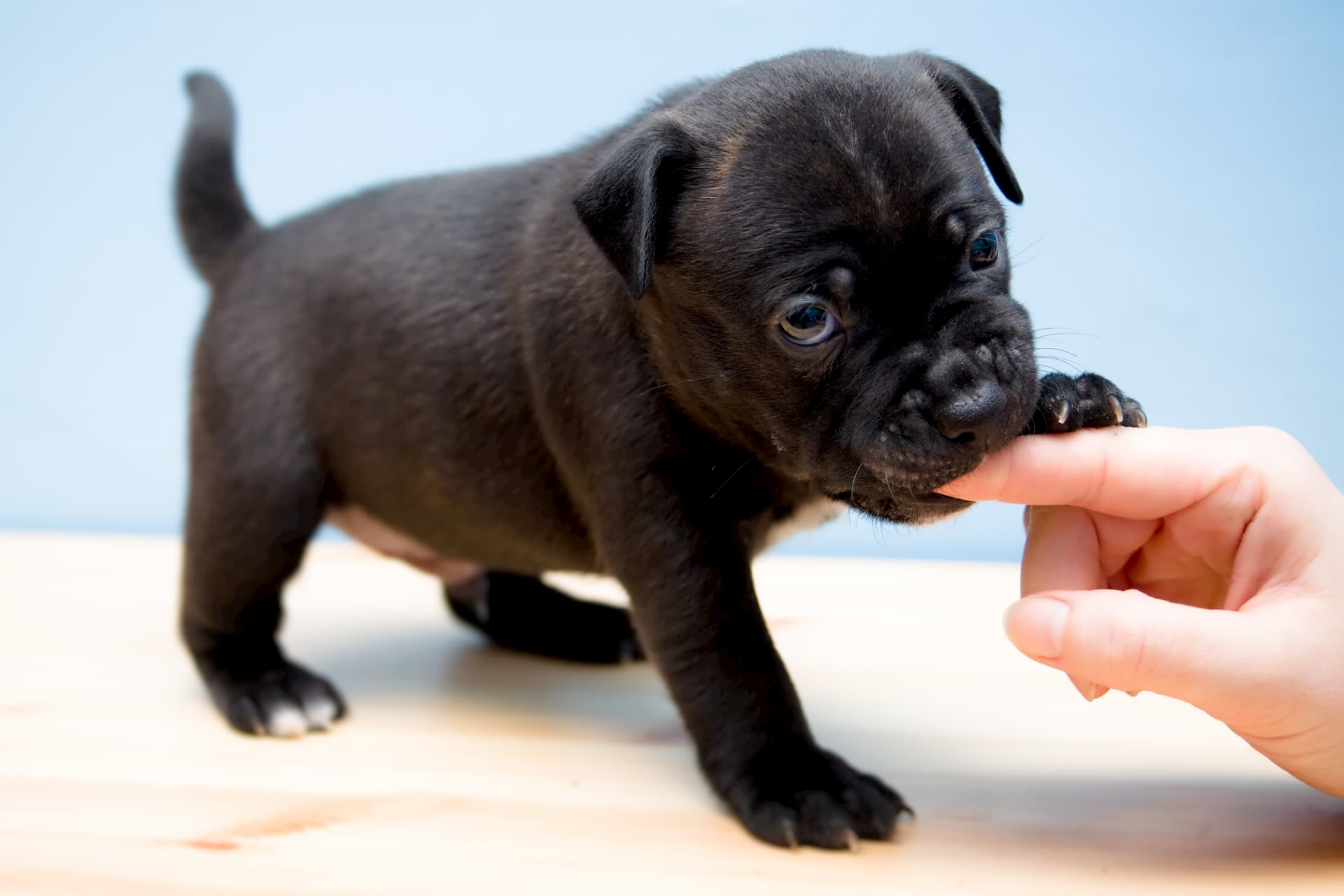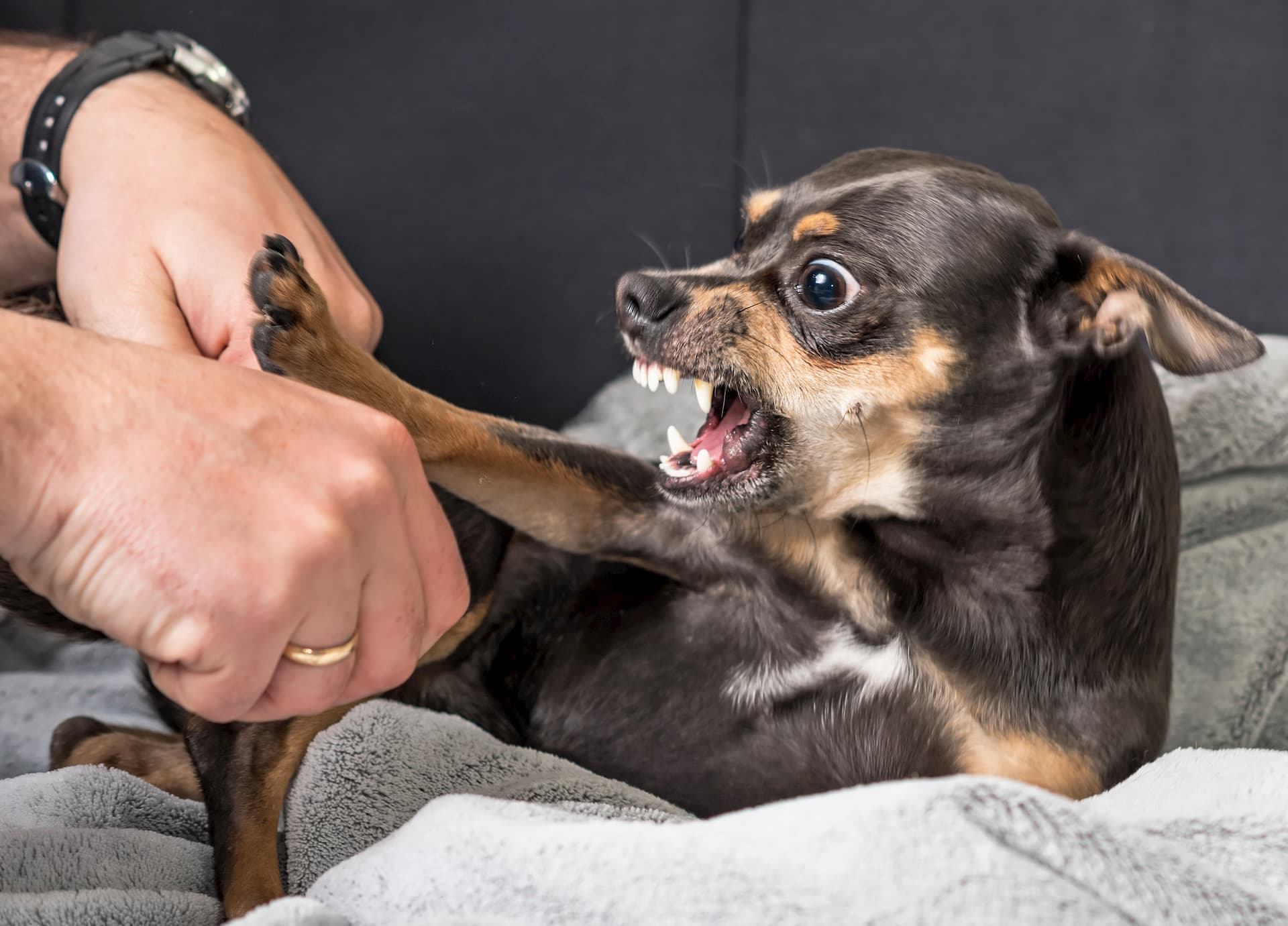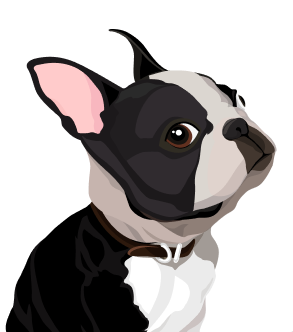Most owners are not really pleased when their dog bites their hands strongly or grabs clothes during a game. An adult dog bites much more painfully than a little puppy. Besides, it is harder to tackle adult dog biting because older dogs are bigger and much harder to control.
As a rule, painful biting is typical for those adult dogs which were not educated to use their teeth properly when they were puppies.
Is biting during a game a sign of aggression?
Using teeth is a normal species-typical behavior of a dog, because teeth are one of the major tools for exploring the world. It is important that game bites do not injure the person and do not cause pain. Game bites, even serious ones, are not signs of aggression but some dogs bite when they are scared. And sometimes it is hard to distinguish between game bites and bites which are followed by aggressive behavior.
In most cases, bites are accompanied by a dog’s body language saying that the dog is relaxed. The dog can wrinkle their nose, but their facial muscles will not look tense. Game bites are usually not as painful as the aggressive bites. An aggressive dog looks tense and they attack sharply and quickly.
If you consider your dog to be aggressive, the best you can do is to consult a qualified canine specialist.
How do you teach your dog not to bite?
Dogs spend much time playing, chewing something or exploring different objects. Obviously, they like playing with people. Puppies chew our fingers and grab our legs because they explore the human body in such a way – as they don’t have hands, they do it with their teeth. This behavior is cute for a 2-month old puppy, but it is not at all funny when the dog is 2 or 3 years old.
That’s why it is very important to teach the dog to control their teeth and use them carefully when playing. There are several ways to teach a puppy to control the strength of a game bite. These are based on the fact that we show the dog that our skin is very sensitive, and that’s why it is important to be careful when playing. Besides, if you teach the dog to bite softly, it won’t bite with force, even in the most critical situations, for instance, when the dog is scared.
Puppies learn to control the strength of their bites when playing with other puppies. If you watch a group of dogs playing, you will definitely notice chases, attacks and struggle. And from time to time (not rarely!) the dogs grab each other with teeth during the game, sometimes – very strongly.
As a rule, the “victim” squeals and stops the game. It is negative punishment in action! Meanwhile, the “offender” usually jumps to the side and stops. However, the game recommences soon. This is how dogs learn to control the strength of their bites when playing with each other. And if the dogs are able to learn when playing with one another, they surely can learn when playing with humans.
That’s why there’s no need to ban game bites completely, but if the dog hurts you with a bite during a game, abruptly cry out and stop playing. This is supposed to be a signal for the dog to stop biting.
If the exclamations don’t work, you can give a marker of improper behavior (for example, “No!”) pronounced in a stern voice. Praise the dog if they’ve stopped biting you and started licking your hand. Recommence the game. However, do not let the dog get over excited as they can lose control in this case.
If the squeals and the misbehavior markers do not work, take a break. If the dog strongly bites you during the game, cry out and ignore the dog for 10-20 seconds. If the dog continues to attack, send it to another room for 10-20 seconds or leave the room yourself.
It is very important to show that strong bites end all the fun and that only polite playing is appropriate. After that you can continue playing.
11 tips on how to teach your dog not to bite when playing
Here are some tips that will help you to play with your dog safely.
- When the dog tries to grab you with their teeth, switch their attention to a toy or a chewing treat.
- Dogs often grab people’s hands when they are scratched or squeezed. If your dog behaves in such a way, feed them with small pieces of a treat, while petting or scratching. This will help your dog to get used to the fact that it is not necessary to grab people’s hands when they touch them.
- Encourage non-contact forms of playing such as hauling rather than using hands. However, avoid overexcitement when the dog grabs hands instead of a toy – stop the game earlier.
- Teach the dog to control their impulses using appropriate games and exercises.
- Change toys so that your dog is never bored with them and offer toys and treats which your dog can chew, instead of having fun with your hands or clothes.
- Give your dog a chance to play with other vaccinated and friendly dogs. This will help the dog to release their energy and there will be no need to play rough games with you.
- Give a sudden and loud yelp – very likely it will make the dog stop. If it doesn’t help, use a timeout once the dog’s teeth have touched your skin.
- Do not provoke your dog to play by waving your hands in front of their nose. By doing so, you almost provoke the dog to bite you.
- Do not forbid the dog to play with you in general. Games are an essential way to build a trusting and close relationship with your pet. It is important to teach your four-legged friend to play correctly, not to discourage them from playing at all.
- Do not pull your hand away when the dog grabs you with their teeth. Such movements look like encouragement of the game, and most likely the dog will jump forward to catch the “escaping prey”.
- If you pet the dog during the game, you provoke them to bite more strongly. Physical punishments can also provoke bites and even cause real aggression.
What are the types of dog bites?
There are 3 main categories of dog bites:
- Puppy nipping related to teething (up to 5 months).
- “Exploration” mouthing (when a puppy bites with their incisors).
- Bites caused by low-level conflict aggression (the puppy bites with a full mouth, pulls, shakes their head and shows clear warning signals). Conflict aggression occurs when you force the puppy to do something that they don’t want to do, or you don’t let the puppy do what they want.
Major ‘no’s for teaching your dog to stop biting
Never, ever hit or otherwise physically punish your dog and completely prohibit him from biting.

It is important to let the puppy bite you, because this is how they will understand your pain threshold. If you prohibit your pup from biting, they won’t understand how much force they can apply and they will bite you the way they bite other dogs.
If the puppy’s bites are a manifestation of conflict aggression, then punishments and prohibitions will only reinforce this aggression.
In the short term, the dog’s bites will become more intense, and in the long term, such a dog may become too dangerous for those who are around them.
The most important steps in teaching your puppy to stop biting
When you teach the puppy to play gently, never reward them for painful bites but always reward them for being careful.
It is quite easy to do so. Play with your puppy when they are gentle, and immediately stop the game when they bite too hard. Playing is a natural reward for puppies.
It makes sense to increase the requirements to your puppy gradually. If you immediately impose sanctions on your pup for all the more or less noticeable bites, that would be too much for them, and they will not understand what is required from them. “Shall I not bite hard or shall I not bite at all?”
This is not to mention the fact that frequent mistakes lower self-esteem and significantly discourage the puppy from learning.
So, once again, increase the requirements gradually.
Firstly, “punish” your pup by stopping the game only for very strong bites. When there are no such bites, stop the game after strong bites, then – after moderate ones.
Repeat this until all your puppy’s bites become comfortable for you. Some might find it comfortable when the pup touches the skin with their teeth, some don’t mind weak bites, and some may find rough play with bruises appropriate. You should determine your own limits of what is acceptable.
If your puppy bites you too hard, give a sharp “Ouch!” yelp, and stand still for 5-10 seconds until the puppy calms down.

Don’t shout too excitedly as impressionable puppies can get too scared, and some puppies (for example, Terriers) can find it even more interesting to bite such a funny “squeaking toy”.
In addition to standing still, you can cross arms on your chest so that the puppy has no chance to bite them, and turn your head to the side and up (in a dog’s language, this means “I don’t want to communicate with you”).
When the puppy has calmed down, you can continue playing with them.
If the puppy bites you hard three times in a row or continues to bite you despite the fact that you are standing still, take a time-out and leave, therefore ending the playing session.
If your puppy gets over excited, you can stay in this room but put the puppy in a crate or a playpen, or take them to another room (no longer than 1 minute). Wait until the puppy calms down and only then let them free.
The main rule is “If you bite too hard, the game is over”.
If you switch your puppy’s attention to a toy, do it carefully and correctly.
Switch the puppy’s attention to a toy, hold their attention for a few seconds, wait until the puppy does the “right” thing and only then give them this toy as a reward.
If you give your puppy a toy as soon as they switch their attention from your hand or foot to it, you will unwittingly reinforce the biting. The puppy may decide that biting is a great way to make you play or get what they want.
What should I do if my puppy bites my child?
If your puppy bites your child, who is not able to use the previously mentioned methods correctly, you can try putting them on a lead.
Firstly, familiarize your puppy with the leash or a lead, so that they understand that the only way to “get free” is to be calm and sit or lie down silently.
So, put your puppy on a short (1.5-2 meter) lead, and let your child play with them.
When the puppy bites the child painfully, the child should say “Ouch!” (this is not obligatory) and move away from the puppy to such a distance that the puppy can’t reach them.
When the puppy has calmed down, the child can come closer to them and continue playing.
